| |
|
|
|
| |
|
| FOOD & BEVERAGES |
|
|
|
| |
|
| 1. Jelly |
|
Jelly is something popular to spread on one's bread, but is also used as additive to yoghurt, skimmed milk and so on. The jelly mainly consists of the respective fruit juice, which is thickened, i.e. gelled with the aid of preserving sugar with a certain content of pectin and citric acid. If necessary colorants or flavour enhancers etc. are added during cooking of the jelly. |
|
| |
|
| Productions in a circulating inline process |
|
| |
|
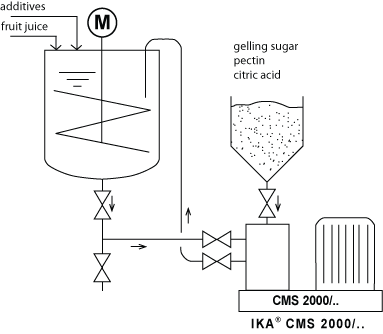 |
|
- In order to solve the sugar and for quick wetting and thus avoiding pectin agglomerates it is necessary to mix the components quickly under controlled shear stress. The IKA® mixing and dispersing machine type CMS 2000 is the perfect machine to meet these requirements.
- The necessary quantity of fruit juice is in the cooking vessel, first at ambient temperature in order to avoid a too early thickening. The solids quantities corresponding to the recipe are fed to the CMS 2000 via a funnel. The CMS is sucking the solids and solves resp. disperses them in the fruit juice, free of agglomerations. It has to be taken care that the sugar is solved in approx. the same time period that is needed for thickening due to the pectin. For this purpose the product is cooked and preservatives, colorants and flavour enhancers may be added.
|
|
| Back to top |
|
| |
|
| 2. Pectin |
|
Pectin is a polysaccharide which, in solved condition, is used as thickener or former of a gel, e.g. in aqueous or oily phases. It is mainly gained from fruits, especially from apples, but also from roots or leaves. The application is similar to that of all hydro colloids, i.e. guar gum, alginate, Carragen, Tragant, Agar Agar and similar. Pectin parent solutions have a concentration between 2% and 5%.
|
|
| |
|
| Batch Processing |
|
| |
|
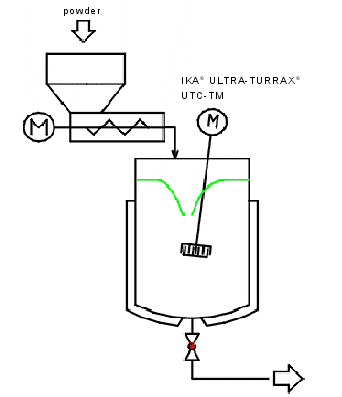 |
|
- Due to their fine particle size (fine powder) hydrocolloids tend to agglomerate and, in connection with humidity, to form lumps. Therefore a quick wetting and homogeneous repartition is of great importance. It is known that heat accelerates the swelling behaviour, i.e. the increase of viscosity. It is therefore recommendable to mix the phases homogeneously at low temperature and within short time.
- For the batch process the IKA® ULTRA-TURRAX® UTC is the ideal machine.
|
|
| |
|
| Inline Processing |
|
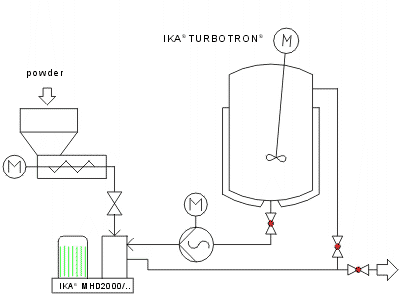 |
|
- When contacting water, pectin tends to form lumps that are very difficult to solve again. Therefore wetting should be made as quickly as possible while dispersing at the same time, so that lumps cannot form. The best machine for this purpose is the inline mixing and homogenizing machine type IKA® MHD 2000/.., which at the same time mixes, disperses and homogenizes water and pectin in defined quantities.
- In case of high concentrations up to approx. 8% solids it results in a nearly plastic, but already homogeneous mixture, which may subsequently be diluted again in a buffer vessel.
The moisture expansion also takes place in this vessel under medium stirring.
|
|
| Back to top |
|
| |
|
| 3. Alginates |
|
| Alginates are salts and esters of alginic acid, which is extracted from algas using a sodium carbonate solution. Due to their good water solubility alginates are used as thickeners, emulsifiers and stabilizers in the food stuff, pharmaceutical and cosmetics industry. Carragen also belongs to the group of the alginates. |
|
| |
|
| Productions in a inline process |
|
| |
|
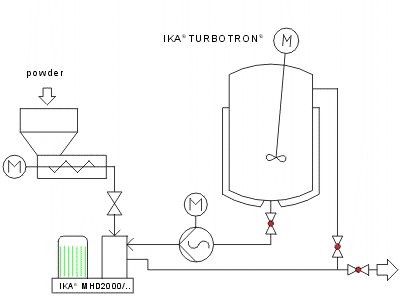 |
|
- Due to their fine particle size (fine powder) hydrocolloids tend to agglomerate and, in connection with humidity, to form lumps. Therefore a quick wetting and homogeneous repartition is of great importance. It is known that heat accelerates the swelling behaviour, i.e. the increase of viscosity. It is therefore recommendable to mix the phases homogeneously at low temperature and within short time.
- For the inline process the IKA® inline powder wetting and dispersing machine CMS 2000 is the ideal machine.
- For continuous processes and very high concentrations we recommend to use the IKA® mixing and dispersing machine MHD 2000.
|
|
| |
|
| Productions in a batch process |
|
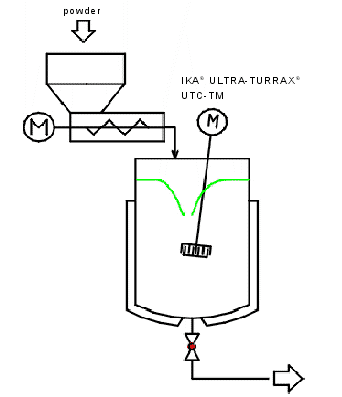 |
|
- Due to their fine particle size (fine powder) hydrocolloids tend to agglomerate and, in connection with humidity, to form lumps. Therefore a quick wetting and homogeneous repartition is of great importance. It is known that heat accelerates the swelling behaviour, i.e. the increase of viscosity. It is therefore recommendable to mix the phases homogeneously at low temperature and within short time.
- For the batch process the IKA® ULTRA-TURRAX® UTC is the ideal machine.
|
|
| Back to top |
|
| |
|
| 4. Protein drinks |
|
Milk drinks enriched with proteins are serving for increase of physical power, mainly in the fields of strength events, body building and stamina training. Since proteins cannot be stored in the body, they have to be supplied via food. Otherwise the body's own protein is consumed, which may have negative effects on condition, stamina and fitness.
Beside the fat and the carbohydrates proteins belong to the main nutrients. They are supplying the basic elements - the amino acids - for antibodies, enzymes and hormones. They also play an important role as messengers and for muscles, skin and hair. Proteins play an important role for anabolic processes like building of peptides and endogenic proteins, but also for catabolic processes, since they are taken as additional direct energy source in case of long lasting physical stress. Excess protein is used by the body for energy production.
Typical ingredients of protein drinks are:
skimmed milk, water, lactic protein, sugar, flavours (banana, strawberry, vanilla, chocolate) and stabilisers.rocess the IKA® ULTRA-TURRAX® UTC is the ideal machine. |
|
| |
|
| Productions in a batch enrichment process |
|
| |
|
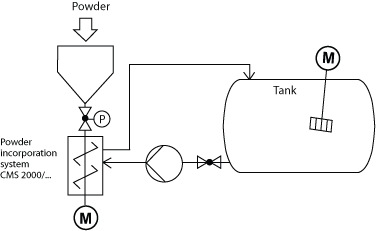 |
|
- Milk drinks for sportsmen are ideally produced in a batch enrichment process. The liquid ingredients like skimmed milk and water are supplied in a container. The powdery ingredients are dispersed into the liquid flow by means of a powder incorporation dispersing machine. This avoids agglomerations and the solving process is accelerated.
- The solids are fed into the powder incorporation machine via a funnel. Special funnel geometries help avoiding a so-called "creation of chimneys" in the dosing vessel. This minimises the introduction of air to the quantity enclosed in the powder, which avoids a building of foam. After the complete incorporation of the solids the final product can additionally be circulated in the machine for further homogenisation. Depending on the recipe resp. the product viscosity a pump may be connected to the powder incorporation machine for support of the flow. The material in the vessel may additionally be mixed by means of a stirrer. After the mixing process itself, the protein drink is sterilised and bottled.
|
|
| Back to top |
|
| |
|
| 5. Native starches |
|
| Native starches belong to the natural hydrocolloids.In the food industry they are mainly applied as stabilizers or thickeners, i.e. the clear swelling property of the starches is used. The best known starches of this kind are: potato starch, cereal starch, rice starch and starch from legumes |
|
| |
|
| Productions in an inline processed bottled |
|
| |
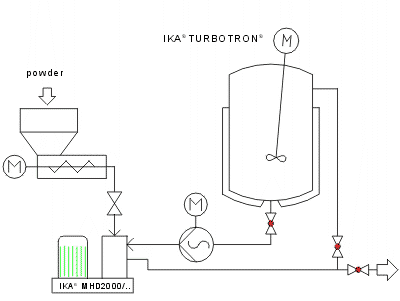 |
|
- Due to their fine particle size (fine powder) hydrocolloids tend to agglomerate and, in connection with humidity, to form lumps. Therefore a quick wetting and homogeneous repartition is of great importance. It is known that heat accelerates the swelling behaviour, i.e. the increase of viscosity. It is therefore recommendable to mix the phases homogeneously at low temperature and within short time.
- For the inline process the IKA® inline powder wetting and dispersing machine CMS 2000 is the ideal machine.
- For continuous processes and very high concentrations we recommend to use the IKA® mixing and dispersing machine MHD.
|
|
| |
|
| Productions in a batch process |
|
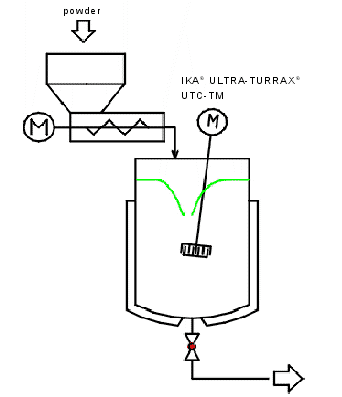 |
|
- Due to their fine particle size (fine powder) hydrocolloids tend to agglomerate and, in connection with humidity, to form lumps. Therefore a quick wetting and homogeneous repartition is of great importance. It is known that heat accelerates the swelling behaviour, i.e. the increase of viscosity. It is therefore recommendable to mix the phases homogeneously at low temperature and within short time.
- For the batch process the IKA® ULTRA-TURRAX® UTC is the ideal machine.
|
|
| Back to top |
|
| |
|
| 6. Polysaccharides |
|
The term "polysaccharides" is a collective name for macromolecular carbohydrates, linked with monosaccharide molecules. Pectins gained from apples or quinces, xanthan or agar agar also belong to this group. They have very good gelling properties and are thus mainly used in the beverage industry, but also for the production of jams, jellies and similar products.process the IKA® ULTRA-TURRAX® UTC is the ideal machine.
|
|
| |
|
| Productions in an Inline Process |
|
| |
|
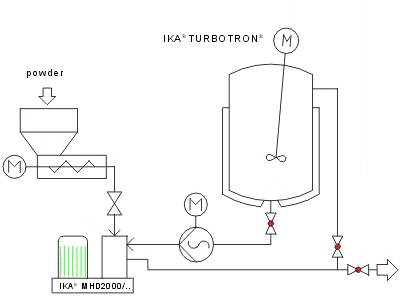 |
|
- Due to their fine particle size (fine powder) hydrocolloids tend to agglomerate and, in connection with humidity, to form lumps. Therefore a quick wetting and homogeneous repartition is of great importance. It is known that heat accelerates the swelling behaviour, i.e. the increase of viscosity. It is therefore recommendable to mix the phases homogeneously at low temperature and within short time.
- For the inline process the IKA® inline powder wetting and dispersing machine CMS 2000 is the ideal machine.
- For continuous processes and very high concentrations we recommend to use the IKA® mixing and dispersing machine MHD 2000
|
|
| |
|
| Productions in a Batch Process |
|
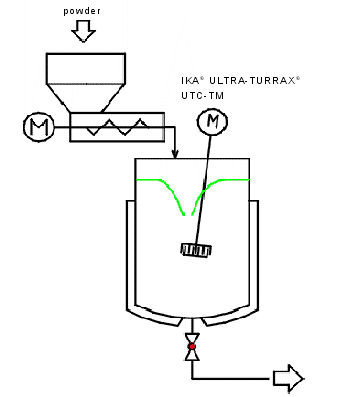 |
|
- Due to their fine particle size (fine powder) hydrocolloids tend to agglomerate and, in connection with humidity, to form lumps. Therefore a quick wetting and homogeneous repartition is of great importance. It is known that heat accelerates the swelling behaviour, i.e. the increase of viscosity. It is therefore recommendable to mix the phases homogeneously at low temperature and within short time.
- For the batch process the IKA® ULTRA-TURRAX® UTC is the ideal machine.
|
|
| Back to top |
|
| |
|
| 7. Salad sauces & dressings |
|
Salad sauces or dressing are O/W-emulsions which specially serve for flavour inprovement. They are a typical side product of the fastfood development. The aim is to get a tasty sauce suiting to your salad within short time. Moreover, you do not have to compose the respective components yourself and to mix them manually to an emulsion.
|
|
| |
|
| Productions in a Batch Enrichment Process |
|
| |
|
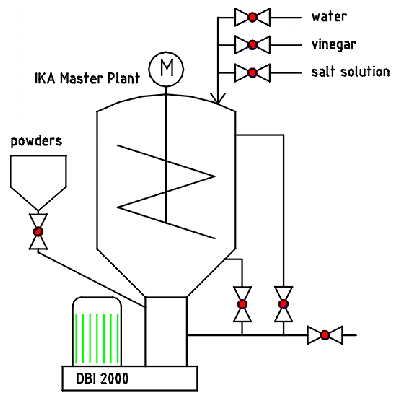
|
|
| Emulsions for salad sauces and dressings are usually produced in 2 steps. |
|
- First salt, colorants, preservatives, spices, etc. are dispersed into the continuous phase, i.e. water with vinegar. Preferably high shear dispersing machines of type IKA® ULTRA-TURRAX® UTL 2000 or DBI 2000 are used for this purpose.
- Adding the disperse phase, i.e. oil and a suitable emulsifier, results in an emulsion. For further stabilisation and thickening stabilisers like e.g. guar gum, pectin or xanthane may be used. Often so-called "visible" spices are added at the end of the emulsifying process.
|
|
| |
|
| |
|
| 8. Mustard or mustard sauces |
|
Mustard is one of the most frequent spices for meat and sausages. The raw material are the seeds of the mustard plant, which are very small, hard balls which have to be ground to powder before they can be processed.
Mustard sauces serve for flavour improvement or adaptation. Therefore they are produced acc. to the most different recipes.
The main ingredients are:
- Water, saltwater and vinegar as liquid components
- Ground mustard, thickener (e.g. xanthan or guar gum), further spices and maybe sugar as solid ingredients.
|
|
| |
|
| Processing in a Batch Process |
|
| |
|
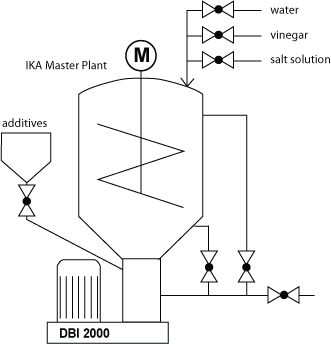 |
|
| |
|
- Giving the liquid components acc. to recipe into a mixing vessel
- The solids - in most cases starting with the mustard powder - are directly dosed into the DBI 2000/.. via a funnel and intensively mixed and dispersed in a circulating process. Care has to be taken regarding the viscosity and the speed may have to be adjusted.
|
|
| Back to top |
|
| |
|
| 9. Processing of vegetable oils |
|
| Vegetable oils are an important ingredient in many cosmetic products. Nevertheless, before they can be used, they have to be "degummed".For this purpose proteins, carbides and phosphatides, that cloud the oil and are responsible for conglutination effects, have to be removed. Afterwards free fatty acids, that accelerate the spoiling of the and also influence the taste, are removed by neutralization. The subsequent bleaching not only removes colours but also metals, traces of phosphatides, soaps and oxidation products. |
|
| |
|
| Processing in an Inline Process |
|
| |
|
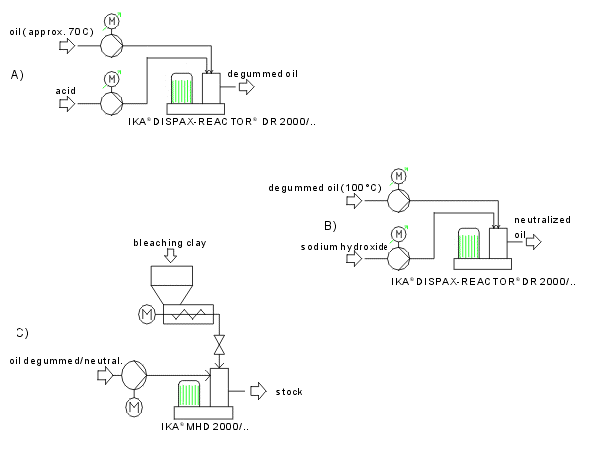 |
|
| Vegetable oils are processed in following steps: |
|
| |
|
1. Degumming
art of the phosphatides in the raw oil are hydrogenizable with water and can thus easily be separated. The remaining non-hydrogenizable phosphatides can be separated by adding acid.
The untreated oil is heated up to 60°C - 70°C and thoroughly mixed with up to 1% of phosphoric acid. The acid is reacting with the phosphatides, thus enabling a settlement of the water. The phosphatides can then be separated by filtration or centrifuging. This results in a "degummed" oil and gum resin, from which, under certain conditions, lecithin can be produced. For a thorough mixing of acid and oil the IKA ®-dispersing machine type DISPAX-REACTOR ® DR 2000 proved to be very suitable. |
|
| |
|
| 2. Neutralization |
|
| Free fatty acids (FFA) are influencing the taste of the oil and accelerate its spoiling. For neutralization of the FFA the oil is intensively mixed with sodium hydroxide at a temperature of approx. 90° to 100°C. The FFA are settling as soaps and can be sperated by centrifuging. The DISPAX-REACTOR ® DR 2000 as well as the single stage dispersing machine of type ULTRA-TURRAX ® UTL 2000 proved to be the right machines for neutralization of the FFA. |
|
| |
|
| 3. Bleaching |
|
| In order to remove remaining impurities like colour and oxidation products the oil can finally be bleached. For this purpose it is intensively mixed with bleaching clay. For this process we recommend the IKA ® inline mixing and dispersing machine type MHD 2000. |
|
| Back to top |
|
| |
|
| |
|















